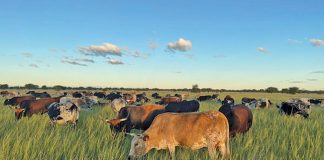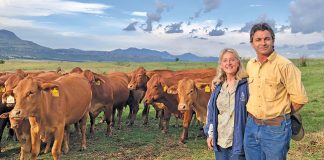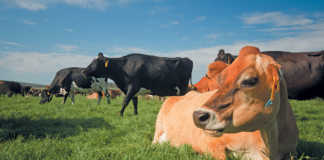Roundworms
Test anthelmintics for parasite resistance using the faecal egg count resistance test (FECRT) as one vet wrote in a report: “Stock farmers are losing the battle against resistant roundworms.”
Flukes
Animals that grazed in vleis during winter will be infected with liver fluke. Discuss control and management programmes with your vet. Signs of liver fluke are a bottle jaw and anaemia.
Cysticercosis (measles)
Reports were received from Mpumalanga, North West and the Western Cape. Source the origin of the infestation and institute preventative measures. Train workers about the life cycle of Taenia saginata, the human tapeworm.
Turning disease, caused by a cyst (Coenurus cerebralis) on the brain, was diagnosed in goats in Upington. Tapeworm is present in dogs and other carnivores and when sheep or goats take in the eggs, a cyst may develop in the brain. Remember to treat sheep dogs regularly for tapeworms.
Coccidiosis
Numerous reports of infestation with this protozoal parasite were received. Young animals are especially affected. Discuss preventative measures with your vet.
EXTERNAL PARASITES
Ticks
There was a big increase in blue tick numbers. Ensure that the control measures used are effective. Blue ticks transmit African and Asiatic red water, anaplasmosis, lumpy skin disease and cause blood loss.
Reports of the presence of the following tick species were received:
- Blue ticks: Mpumalanga, Limpopo, North West, Free State, KZN, Eastern and Western Cape
- Heart water tick: Mpumalanga, Gauteng, Limpopo, North West, KZN, Eastern and Western Cape. Volksrust reported that this tick was seen in the area for the first time.
- Brown ear-ticks: Limpopo, Free State, KZN and Eastern Cape
- Bont-legged ticks: Mpumalanga, Gauteng, North West, KZN and Western Cape.
- Red-legged tick: Mpumalanga, Limpopo, North West, Free State, KZN and Western Cape. Spring lamb paralysis caused by the red-legged tick was reported in the Free State.
Discuss the life-cycles of these ticks and how to control them with your vet. Engorged blue ticks can be collected and tested for resistance.
Lice
Numbers are decreasing after winter. Farmers with wool sheep should check their sheep regularly for lice as they cause serious disturbance of the fleece.
Mites
Be on the lookout for wool and hair loss. Sheep scab is a state-controlled disease and outbreaks occurred in various provinces. Contact your state vet to find out if there are positive farms in your area. Biosecurity measures to prevent sheep becoming infected should be in place at all times.
Flies, midges and mosquitoes
Numbers are on the increase after good rains in many parts of the country.
TICK-BORNE DISEASES
African and Asiatic red water
The occurrence of these diseases is on the increase as blue tick numbers are on the increase. Reports were received from Mpumalanga, Gauteng, Free State, KZN, Eastern Cape and the Western Cape. Discuss vaccination programmes with your vet.
Anaplasmosis
Numerous reports of outbreaks were received from all provinces except the Northern Cape. This disease is spread by blue ticks, biting flies and needles (vaccinations).
Heartwater
Mpumalanga, Gauteng, Limpopo, North West, KZN and Eastern Cape. The occurrence of this disease is spreading as a result of game transporting the bont tick into non-infected areas.
These diseases can be controlled through vaccination, fly and tick control. Discuss control measures with your vet to prevent heavy losses.
INSECT-TRANSMITTED DISEASES
Lumpy skin disease
Reports were received from Mpumalanga, Limpopo, Free State, KZN and the Eastern and Western Cape. This confirms that some species of ticks are also capable of transmitting the virus causing lumpy skin disease. Most cases occurred in animals that had never been vaccinated. If there is an outbreak on a farm the virus can also spread via the saliva, therefore isolate diseased animals as soon as possible.
Three day stiff sickness
Only a few cases (Mpumalanga, Limpopo, Eastern and Western Cape) were reported.
Blue tongue
Gauteng, Free State, Eastern, Western and Northern Cape. There’s a problem with the availability of vaccine. Discuss additional control measures with your vet.
Rift Valley Fever and Wesselsbron disease
No reports were received.
VENEREAL DISEASES
Trichomonosis
This venereal disease is causing havoc in SA. Only Gauteng did not report an occurrence. Many farms that were previously free of the disease are now positive. It’s of the utmost importance that biosecurity measures are in place.
Vibriosis
Regular reports are received. Good vaccines exist to control this disease.
VIRAL DISEASES
Bovine malignant catarrh (snotsiekte)
North West, Free State, KZN and Eastern Cape. At present there is no vaccine available. Discuss preventative measures with your vet. Remember there is also a sheep associated snotsiekte virus.
Other viral diseases reported were: rabies, infectious bovine rhinotracheitis (IBR), bovine viral diarrhoea (BVD), enzootic bovine leucosis (EBL), orf and warts.
Bovine respiratory disease (BRD) was reported from all over the country with high mortality figures. Many of the viruses mentioned above are involved. Discuss with your vet how to control this disease with a vaccination programme.
BACTERIAL DISEASES
The following were reported: blackquarter, intra uterine gangrene, pulpy kidney, lamb dysentery, swelled head, red gut, blood gut, tetanus, botulism, listeriosis, salmonellosis, bovine brucellosis, ovine brucellosis, tuberculosis, Johnes, leptospirosis, enzootic abortion, colibacillosis, Fusibacterium necrophorum, pasteurellosis and lumpy wool.
Many new brucellosis infections were reported mainly due to the purchase of positive animals. Remember heifers that have the disease might only start to test positive after they are five months pregnant!
There are vaccines for most of these diseases.
POISONINGS
The following toxicities were reported: cardiac glycoside, slangkop, tulip, ink berry (Cestrum), Cynanchum (klimop), facial eczema, rye grass, dikoor, geeldikkop, gifblaar, gousiekte, Lantana, krimpsiekte, Senecio, vermeersiekte, ganskweek, Galenia africana (geelbos), prussic acid, diplodiosis, mycotoxicosis, urea, copper, organophosphate, acidosis and snake bite.
NUTRITIONAL DEFICIENCIES
Many reports were received of animals unable to get up due to a lack of energy and protein. A poor nutritional status means cows have difficulty in calving, retained placentas, prolapses and metritis. These animals will also have difficulty in conceiving again.
MULTIFACTORIAL DISEASES AND OTHER CONDITIONS
The following were reported: abscesses, bladder stones, blindness, opthalmia, bloat, blood gut, blue udder, mastitis, diarrhoea, joint ill, lameness, navel ill, trauma, downer cows and pneumonia.
METABOLIC CONDITIONS
The following were reported: acidosis, displaced abomasum, ketosis and milk fever.
REPRODUCTIVE DISORDERS
The following were reported: abortions, dystocias, endometritis, metritis, poor conception, retained afterbirths and prolapses.
FEEDLOT REPORT
Sheep feedlots
- Dusty conditions were less with the result that pneumonia cases decreased.
- Typically seen at the end of winter and in spring are: weak lambs having problems with adaptation due to poor nutrition, Vitamin A deficiency and diarrhoea.
- Cases of E.coli and salmonellosis occurred and caused mortalities.
- Wireworm infestation are on the increase.
Cattle feedlots
- Cases of red water, anaplasmosis and heartwater occurred.
- Pneumonia caused mortalities during dusty and windy conditions before rainfall commenced.
- Windy conditions also contributed to mortalities due to acidosis, blot and red gut. Some of these animals fattened in the feedlot but at the abattoir their organs were condemned due to pneumonia and peritonitis.
- Blackquarter was the cause of several mortalities in spite of good vaccination programmes. Some cattle do not immunize well to vaccinations.
- Cases of E. coli and Salmonella infections were diagnosed in calves.
- Calves on harvested crop fields contracted diplodiosis, but only a few died.
- Cestrum (ink berry) poisoning caused losses in cattle.













